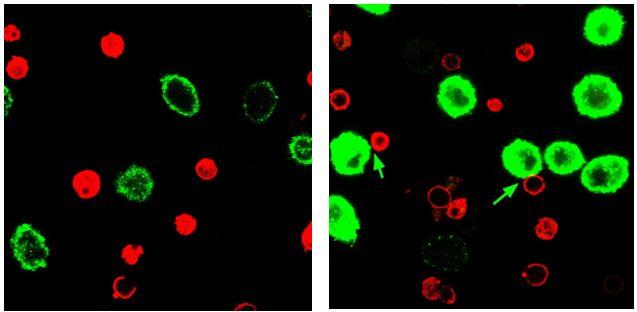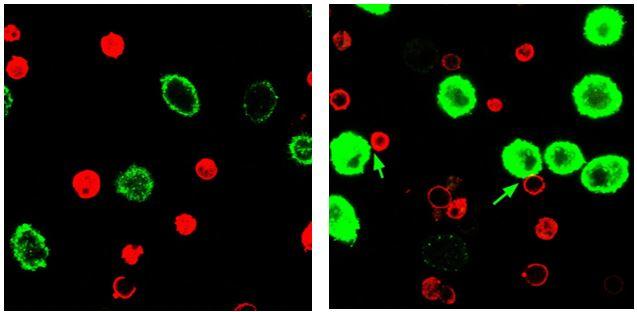
Credit: Alyssa Kosmides, Johns Hopkins Medicine
Scientists at Johns Hopkins have created a nanoparticle that carries two different antibodies capable of simultaneously switching off cancer cells' defensive properties while switching on a robust anticancer immune response in mice. Experiments with the tiny, double-duty "immunoswitch" found it able to dramatically slow the growth of mouse melanoma and colon cancer and even eradicate tumors in test animals, the researchers report.
The findings, described online June 7 in ACS Nano, could lead to ways to boost the effectiveness and promise of immunotherapies in people with cancer, the investigators say.
"Immunotherapies have significant potential and yet room for improvement," says Jonathan P. Schneck, M.D., Ph.D., professor of pathology in the Johns Hopkins University School of Medicine's Institute for Cell Engineering and a member of the Johns Hopkins Kimmel Cancer Center. "The improvement here was to make, for the first time, a nanoparticle that can interact simultaneously with multiple types of cells in the complex tumor microenvironment, dramatically increasing its effectiveness."
Schneck and study co-leader Alyssa K. Kosmides, a graduate student in his laboratory, explain that several cancer treatments designed to stimulate a patient's immune system to fight the disease have been approved by the U.S. Food and Drug Administration, including three known as checkpoint inhibitors. Those drugs help overcome cancer cells' ability to evade a person's immune system by using antibodies to shut down proteins on tumor cell surfaces that hide them from immune cells.
However, they point out, checkpoint inhibitors work only in a relatively limited number of patients and against a small number of cancers so far. Follow-up studies show that overall response rates against melanoma, bladder cancer, Hodgkin's lymphoma and non-small cell lung cancer is around 30 percent, and complete response rates, resulting in eradication of a patient's tumors, are as low as 5 percent.
But combining multiple forms of immunotherapy in doses high enough to be effective can cause severe, even life-threatening, side effects.
For their study, the Johns Hopkins researchers combined two different immunotherapy strategies on manmade nanoparticles about 1,000 times smaller in diameter than a human hair, similar to drug-delivery platforms already in use in some cancer therapies, including chemotherapies such as Doxil, Abraxane and Myocet.
Nanoparticles have clear advantages over free drug, Kosmides explains, such as their "enhanced permeability and retention effect," which causes nanosized particles to be taken up more readily by tumor cells than by healthy cells. Additionally, each particle can hold dozens of antibodies at once, which dramatically raises the local concentration of antibodies. This makes them more effective and reduces the chances of side effects, she says.
"Nanoparticles provide more bang for your buck," Schneck says.
Using paramagnetic iron particles about 100 nanometers in diameter, the researchers placed two different kinds of antibodies on them: one blocks a protein called programmed death ligand 1 (PD-L1), which cancer cells use to cloak themselves from immune cells; another that stimulates T cells, a type of immune cell that fights cancer. By combining these two functions, Schneck explains, the goal was to effectively switch off a tumor's immune-inhibiting ability while simultaneously switching on the immune system's capacity to attack.
In mice injected with mouse melanoma cells, which grew into tumors over the course of several days, only mice who subsequently received the "immunoswitch" particles had significantly delayed tumor growth and longer survival compared to those who received the control treatments or no treatment.
Specifically, the immunoswitch-treated mice had tumors nearly 75 percent smaller than animals that received no treatment, whereas soluble antibody only reduced tumor growth by approximately 25 percent. Half of immunoswitch-treated mice were still alive after 30 days, whereas all untreated mice died by day 22.
"The double-duty immunoswitch particles were clearly more effective than a mixture of nanoparticles that each targeted just one protein and acted in a synergistic fashion, but we don't yet know why," says Schneck. "It may be that the immunoswitch particles' success comes from bringing T cells and their targeted tumor cells into close proximity."
The researchers say they found even more dramatic results in a mouse model of colon cancer. In those experiments, about half the mice had a complete regression of tumors and about 70% could be considered long-term survivors, living more than 55 days.
Looking for the mechanism behind the immunoswitch particles' positive effects, further experiments showed that the particles appear to bring cancer cells and the immune cells that fight them together more easily, providing a synergy that's not possible even with the same two antibodies on separate particles. The immunoswitch particles also were retained in tumor cells significantly longer than soluble antibodies, offering more time for them to work, Schneck and Kosmides say.
The researchers add that they plan to work on improving the immunoswitch particles by searching for more effective combinations of antibodies to include on the platform. Because the particles are magnetic, they also plan to test whether results can be improved by using magnets to guide the particles and keep them at the tumor site.
###
Other Johns Hopkins researchers who participated in this study include John-William Sidhom, Andrew Frasier and Catherine A. Bessell.
The study was funded by the National Science Foundation (grant number DGE-1232825), the National Institutes of Health Cancer Nanotechnology Training Center at the JHU Institute for Nanobiotechnology (grant number 2T32CA153952-06), the National Cancer Institute (grant numbers F31CA206344, R01-CA108835 and R21-CA185819), the National Institute of Allergy and Infectious Disease (grant number P01-AI072677), the TEDCO/Maryland Innovation Initiative and the Coulter Foundation.
Media Contact
Rachel Butch
[email protected]
410-955-8665
@HopkinsMedicine
http://www.hopkinsmedicine.org
############
Story Source: Materials provided by Scienmag





